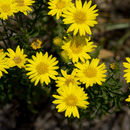en
names in breadcrumbs


The cottony goldenaster, Chrysopsis gossypina, is a member of the sunflower family (family Asteraceae).It occurs in the coastal plain of the southeastern United States, mostly along the Florida panhandle, but extending as far out as Louisiana to the west, and north to Virginia. It likes sandy soils, and grows in the harsh, sunny environments of coastal dune systems and nearby sandhills and scrub.
Cottony goldenasters are short-lived perennials, meaning that individual plants live for 2-3 years. They lose their leaves each winter, and grow anew in the spring from a ring of fuzzy leaves.Although they reach up to about 2.3 feet (70 cm) tall, their multiple stems often fall over as they grow so as larger plantsoccur as vine-like growth along the ground.In the fall, plants can produce up to 30 small, yellow, daisy-shaped flower heads (which are actually composites of multiple tiny individual flowers). The flowers grow so their heads are raised several inches off the sand.
Cottony goldenaster is quite variable over its range.This variability represents three subspecies of Chrysopsis gossypina that grow in mostly non-overlapping areas. The subspecies are primarily distinguished by the fuzziness of their leaves, differences in leaf shape, and mode of growth.
In the Florida panhandle, where these three subspecies overlap, they can hybridize with each other and also with the closely related C. godfreyi.This hybridization makes the identification of individuals a complex task.
(Adams et al. 2010; Huegel 2009; Semple 2013; Wikipedia 2015)